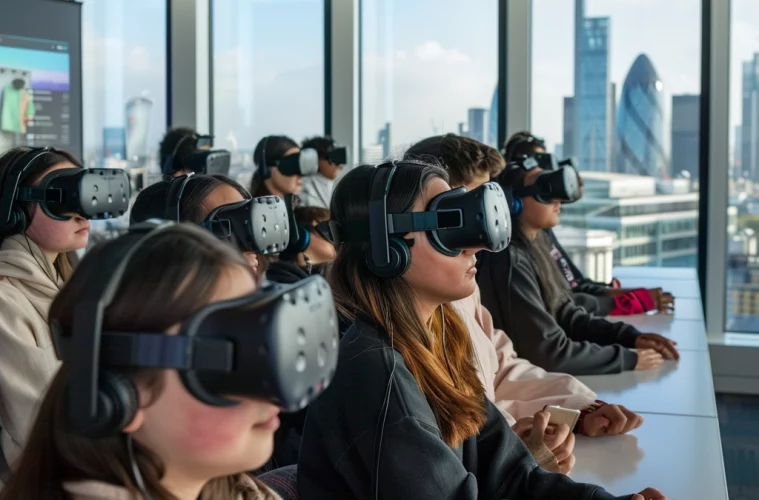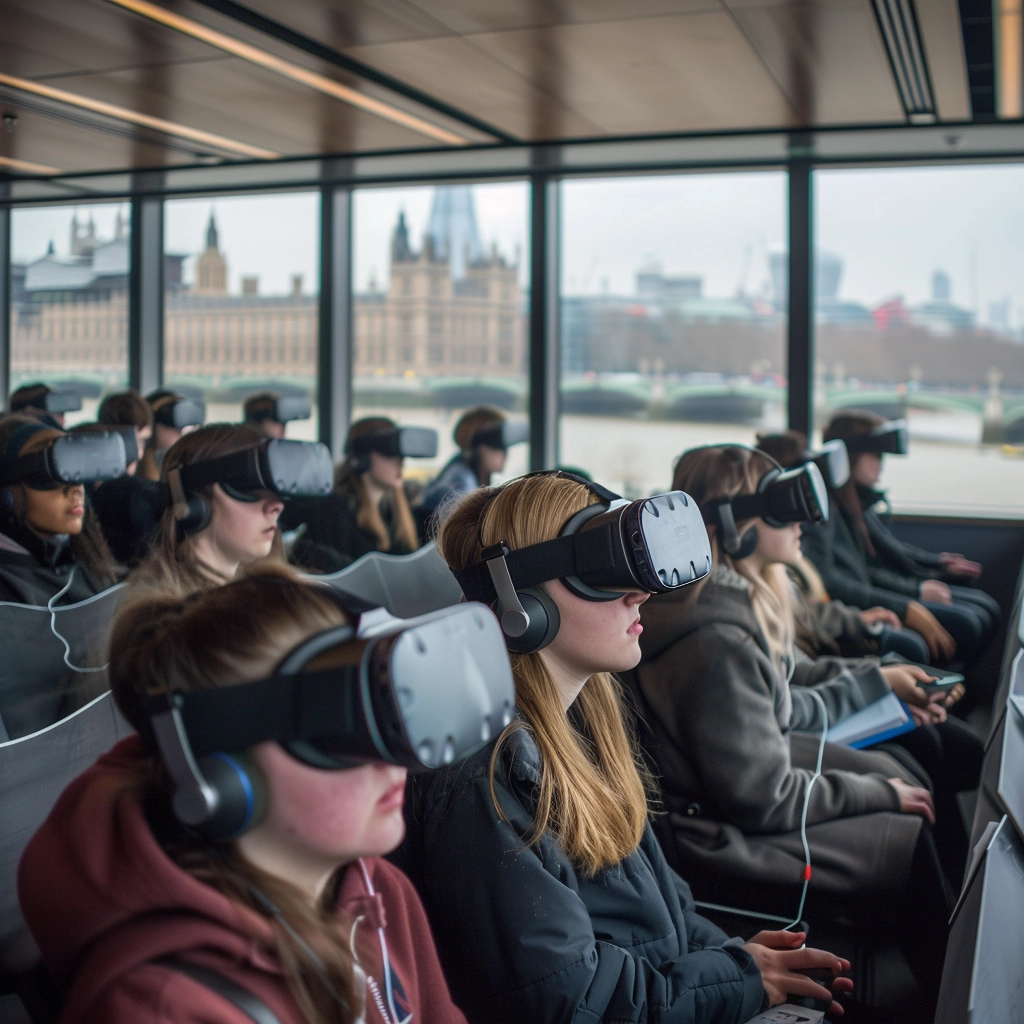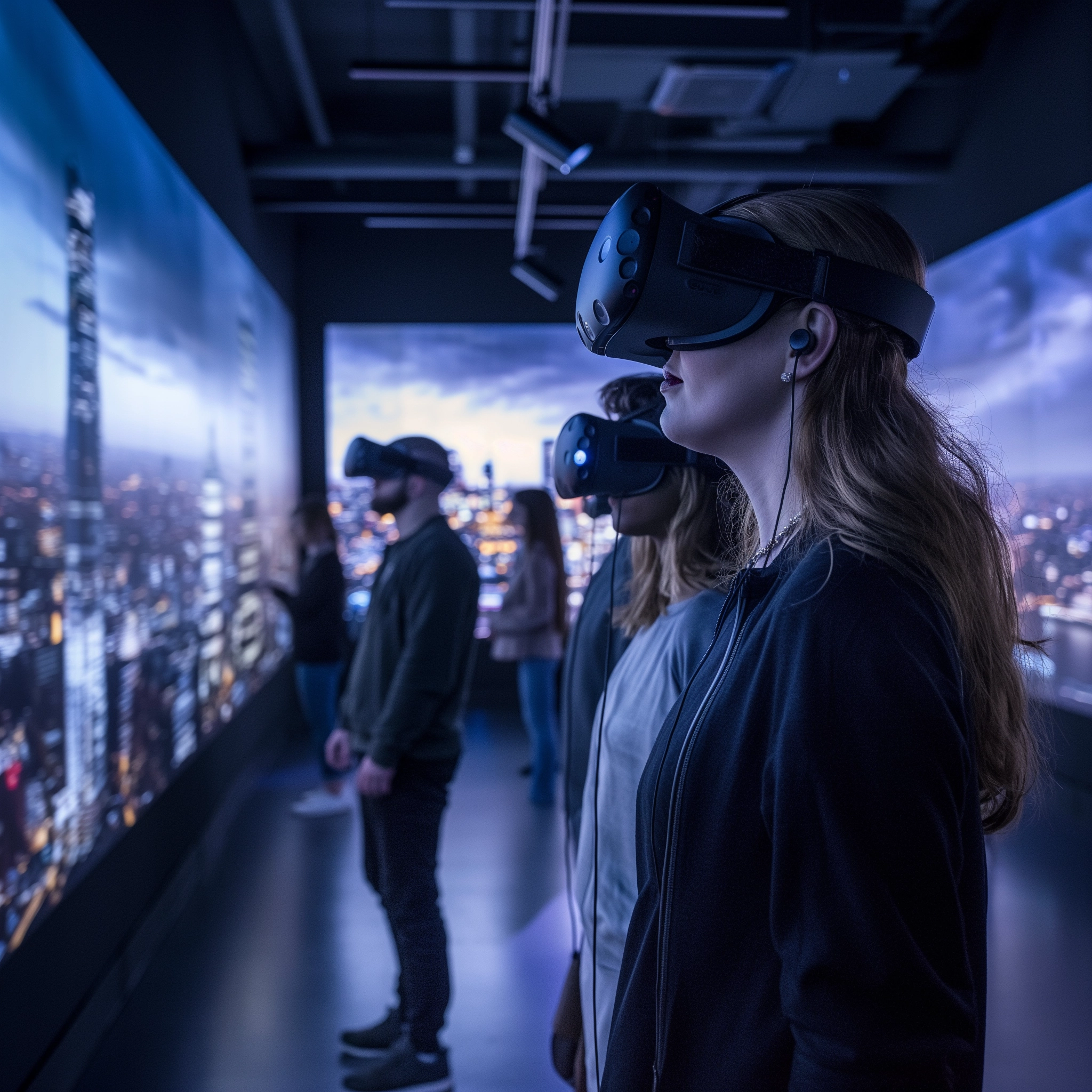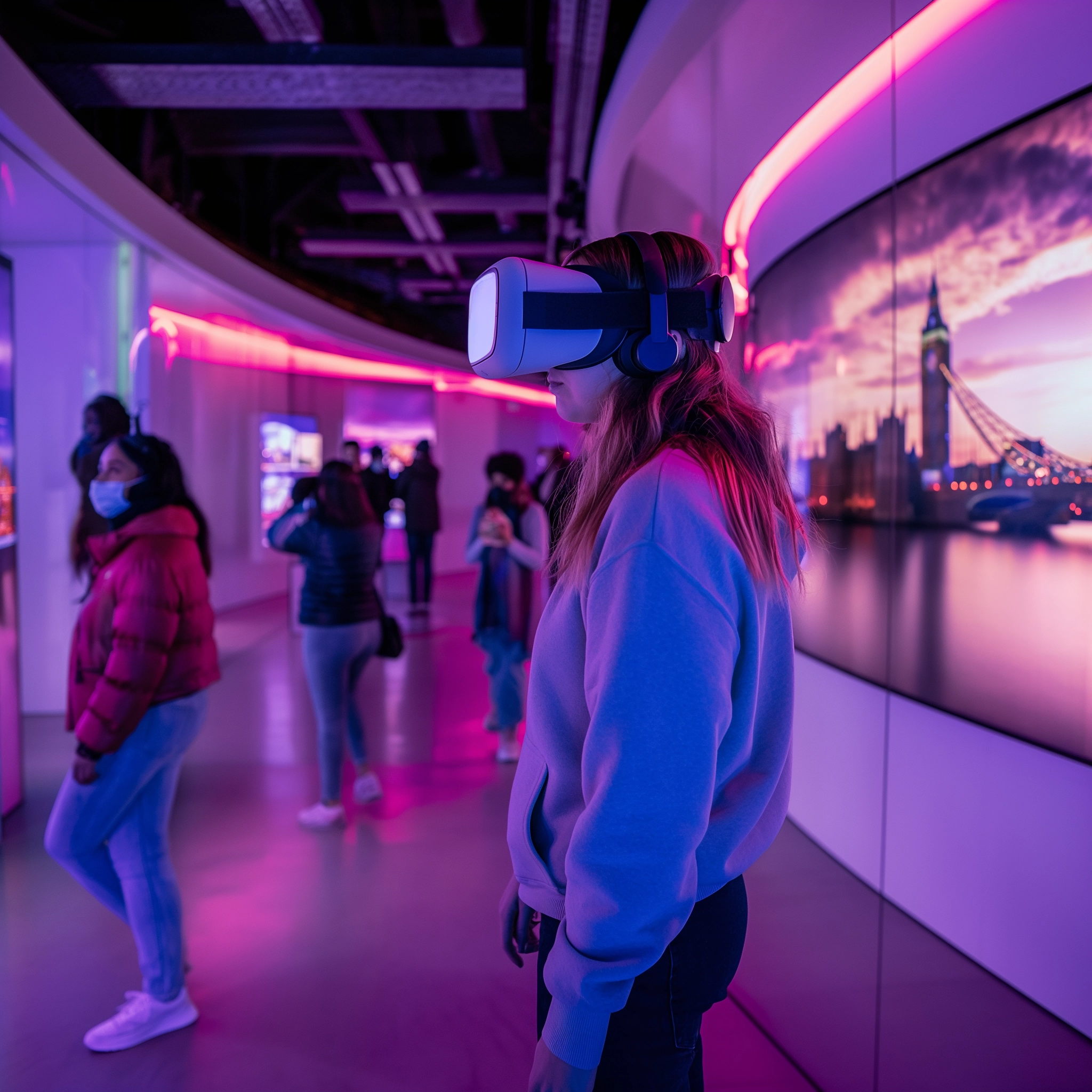Welcome to the Virtual Side of London
London’s leap into the future of tourism and education through virtual reality (VR) is nothing short of revolutionary. The city’s unique blend of historic charm and cutting-edge technology has birthed an array of immersive digital journeys that stand out on the global stage. But what exactly sets London’s VR experiences apart?
London harnesses the latest VR technology to offer experiences that are as educational as they are entertaining. From virtual tours of the Tower of London to VR journeys through the British Museum, these experiences provide an unparalleled depth of immersion. You’re not just a spectator; you’re an active participant in history, art, and culture.
Embracing VR Technology for Tourism and Education
The city has enthusiastically adopted VR to enhance both tourism and educational ventures. Schools are integrating VR into their curriculums, allowing students to explore ancient ruins and modern cities alike, all from the comfort of their classrooms. For tourists, it means experiencing London’s landmarks in a whole new way, without the crowds or the British weather!
London’s VR experiences expertly bridge the gap between traditional attractions and modern technology. They complement physical visits by offering insights and perspectives that would be impossible to achieve in real life. Whether you’re a Londoner, a tourist, or a virtual reality enthusiast, these immersive journeys promise a fresh and exciting way to explore one of the world’s most iconic cities.
Exploring the Best VR Experiences London Has to Offer
London melds its rich historical tapestry with the cutting edge of virtual reality (VR), offering immersive experiences that cater to everyone from history buffs to futuristic explorers. The city’s VR scene is a testament to its innovative spirit, presenting a variety of attractions that not only entertain but educate.
Top-Rated VR Attractions
From virtual tours of ancient London to interactive art installations and sci-fi adventures, the city’s VR attractions are diverse. They’ve earned top ratings for their ability to transport visitors to worlds both old and new, all from the heart of London.
These VR experiences leverage the latest technology to bring historical events to life, offering a unique blend of education and entertainment. Imagine witnessing the Great Fire of London or exploring a Victorian-era cityscape; it’s all possible with VR.
Whether you’re planning a family outing or an adventurous day out with friends, London’s VR offerings have something for everyone. They are designed to be inclusive, ensuring that visitors of all ages can enjoy immersive digital journeys.
Diverse Themes
London’s VR experiences cover a wide range of themes, from historical tours to futuristic adventures, ensuring that every visit is a unique adventure. This diversity not only showcases the city’s rich heritage but also its forward-thinking approach to technology and entertainment.
The Technology Behind London’s Virtual Reality
London’s embrace of virtual reality (VR) is powered by a suite of cutting-edge technologies that push the boundaries of what’s possible in digital experiences. These innovations make the VR experiences not only more immersive but also more interactive, engaging users in ways that traditional media cannot.
The heart of London’s VR experiences lies in advanced VR headsets, motion tracking systems, and haptic feedback devices. These technologies work in tandem to create a fully immersive environment where every movement and action of the user is mirrored in the virtual world, enhancing the sense of presence.
Enhancing User Immersion and Interaction
Through the use of high-resolution visuals, 3D audio, and real-time feedback, users are transported into vividly detailed environments. This level of immersion allows for a more profound connection with the content, turning passive viewers into active participants in their virtual journeys.
The Role of Augmented Reality (AR)
Alongside VR, augmented reality (AR) plays a crucial role in blending the digital with the real world. AR layers virtual objects onto the real environment, providing an additional layer of interaction and exploration for users, further enriching London’s immersive experiences.
Pioneering VR Developers in London
Several London-based VR developers are leading the charge in immersive technology, constantly innovating and exploring new ways to bring virtual experiences to life. These pioneers are setting the standard for what’s possible in VR, ensuring London remains at the forefront of digital exploration.
Virtual Reality Tours of Iconic London Landmarks
London’s storied past and vibrant culture are now accessible in ways previously unimaginable, thanks to virtual reality (VR) tours of its iconic landmarks. These tours offer a unique blend of education and entertainment, allowing you to explore the nooks and crannies of London’s historical treasures from anywhere in the world.
Iconic Landmarks with VR Tours
From the majestic Tower of London to the historic Houses of Parliament, several of London’s most famous sites now offer immersive VR tours. These virtual experiences allow you to wander through centuries-old structures and uncover stories hidden within their walls, all without leaving your living room.
VR tours provide a dynamic viewpoint of London’s landmarks, offering insights into their historical significance in an engaging manner. Imagine standing atop the Shard, overlooking the city as it was hundreds of years ago, or walking through Buckingham Palace’s grand halls from a royal perspective.
These tours are peppered with interactive elements, such as clickable information points, quizzes, and even gamified historical events, making learning both fun and memorable. Through these features, you’re not just observing; you’re actively participating in history.
Preserving and Educating Through VR
Virtual reality tours serve as powerful tools for preservation and education, allowing London’s rich history to be accessible to future generations worldwide. They not only safeguard the past but also ignite a passion for history and culture in a modern and accessible format.
Educational and Cultural Impacts of VR in London
Virtual reality (VR) experiences in London are not just about entertainment; they’re transforming the educational landscape and promoting cultural enrichment. Schools, colleges, and cultural institutions across the city are harnessing the power of VR to bring history, art, and science to life in the classroom and beyond.
VR in Education
London’s educational institutions are integrating VR into their curricula to create immersive learning environments. Students can virtually visit historical sites, explore the human body from the inside, or even travel through space, making abstract concepts tangible and engaging.
Promoting Cultural Awareness
VR experiences offer a unique way to celebrate and understand the diversity of London’s culture. By virtually exploring museums, galleries, and cultural events, users gain a deeper appreciation for the city’s rich heritage and the multitude of stories it holds.
Partnerships with Cultural Institutions
Several VR initiatives in London are the result of collaborations between tech companies and cultural institutions. These partnerships aim to make cultural education accessible to a wider audience, ensuring that everyone has the opportunity to explore London’s history and art through cutting-edge technology.
Enhancing Engagement with Heritage
Immersive journeys through VR significantly enhance engagement with London’s heritage. By offering interactive and engaging ways to learn about the past, VR helps to ensure that the city’s history is preserved and appreciated by future generations.
The Future of Travel and Exploration Through VR in London
The landscape of travel and exploration is set to transform dramatically in London, with virtual reality (VR) leading the charge. As we look to the horizon, new developments in VR technology are poised to redefine the way we experience tourism, not just in London but globally. The future of virtual exploration promises to make the rich tapestry of London’s history, culture, and landmarks accessible to all, breaking down physical and financial barriers.
New Developments in VR Travel
Emerging VR technologies and experiences are being developed to offer even more immersive and interactive tours of London’s iconic sights. These advancements aim to provide hyper-realistic experiences, from the bustling streets of the City to the serene landscapes of the Royal Parks, all from the comfort of one’s home.
Changing the Face of Global Tourism
VR has the potential to revolutionise tourism by offering sustainable, accessible, and comprehensive travel experiences. It allows explorers to visit remote or fragile destinations without impacting their ecological balance, offering a guilt-free way to satisfy our wanderlust.
Initiatives are underway to make VR travel experiences more affordable and accessible. By partnering with educational institutions, libraries, and community centres, VR developers aim to ensure that everyone, regardless of economic background, can explore London and the world beyond.
Sustainability in Virtual Experiences
Sustainability plays a pivotal role in the development of VR travel experiences. By reducing the need for physical travel, VR lessens carbon footprints and promotes environmental conservation, aligning with global efforts to combat climate change. This sustainable approach ensures that future generations can continue to explore and appreciate the wonders of our world.
Behind the Scenes: Creating a VR Experience in London
Creating a virtual reality (VR) experience in London is a journey that takes you from the drawing board to the digital world, blending creativity with cutting-edge technology. The process involves meticulous planning, research, and development to ensure that each VR experience is both historically accurate and engaging.
The development of a VR experience begins with an idea that is then fleshed out through storyboarding, scripting, and conceptualising the virtual environment. Developers use advanced software to build immersive 3D models of London’s landmarks, paying close attention to architectural and historical details.
Creators collaborate with historians and cultural experts to ensure the accuracy of their virtual recreations. Engaging content is crafted through interactive elements and narrative storytelling, making history come alive in a way that’s both educational and entertaining.
Overcoming Development Challenges
Developers face numerous challenges, from ensuring seamless user interaction to optimising VR experiences for different hardware. Balancing high-quality graphics with performance to prevent motion sickness is also a key concern.
User feedback is crucial in the iterative design of VR experiences. Developers conduct user testing sessions to gather insights, which are then used to refine and improve the VR journey. This ongoing process ensures that the final product not only meets but exceeds user expectations, providing an immersive and memorable exploration of London’s heritage.
Comparing Real vs. Virtual Experiences in London
When it comes to exploring London, the choice between virtual and physical tours presents a unique set of advantages and challenges. Virtual reality (VR) offers an innovative way to visit London’s iconic sites, but how does it stack up against actually walking through the historic streets and grand landmarks of the city?
The VR Experience Versus Physical Visitation
Virtual tours of London provide an immersive exploration without the need for travel, offering accessibility to those unable to visit in person. However, they might lack the visceral feeling of standing before the Tower of London or the bustling energy of Piccadilly Circus.
The benefits of VR include convenience, the ability to access restricted areas, and the option to experience London across different eras. Limitations, however, include the absence of the city’s vibrant atmosphere and the tactile sensations of its environment.
VR can complement physical visits by providing historical context and visualising past events at landmarks, enriching the visitor’s understanding and appreciation of each site.
Memorable Takeaways
Visitors often remember the immersive detail and interactive elements of VR tours, such as flying over the Thames or walking through a medieval London virtually reconstructed. Yet, the emotional impact of physically experiencing the city’s grandeur and heritage also leaves a lasting impression, highlighting the unique value of both real and virtual explorations of London.
The Role of Community and Social Interaction in VR Experiences
Virtual Reality (VR) experiences in London are not just about individual exploration; they’re also creating unique spaces for community building and social interaction. Through shared virtual environments, users can connect, communicate, and collaborate, regardless of their physical location. This aspect of VR is reshaping how we think about community and social engagement in the digital age.
VR experiences offer communal spaces where users can meet and interact with others who share similar interests. Whether it’s exploring a virtual representation of London’s historical streets together or competing in multiplayer challenges, VR brings people together in meaningful ways.
Multiplayer and Social VR in London
London boasts several VR experiences designed for multiplayer interaction, allowing friends and strangers alike to embark on adventures together. These shared experiences not only enhance enjoyment but also foster a sense of camaraderie among participants.
By participating in VR experiences focused on specific themes or historical periods, users can connect with others who share their passions. This shared interest lays the groundwork for vibrant communities built around exploring London’s rich cultural tapestry together.
Social interaction within VR experiences significantly enhances user satisfaction by adding a layer of realism and relatability. Sharing experiences, competing, or simply exploring together makes the virtual journey more memorable and impactful, demonstrating the powerful role of community in enriching the VR experience.
Concluding Reflections on London’s Virtual Reality Journey
As we look back on the evolution of virtual reality (VR) experiences in London, it’s clear that this innovative technology has made a significant mark on the city’s cultural landscape. By offering immersive journeys through time and space, VR has opened up new avenues for exploration and education, enriching the way both visitors and locals experience the historical and cultural riches of London.
Lasting Impact on London’s Cultural Landscape
The integration of VR into London’s cultural offerings has not only enhanced the accessibility of its landmarks and heritage but has also introduced a novel way of engaging with history and art. These digital journeys have added a dynamic layer to the city’s narrative, making it more inclusive and diverse.
VR experiences have deepened the appreciation for London’s architecture, history, and art by providing immersive and interactive explorations that were previously unimaginable. They allow for a personal connection with the city’s past and present, fostering a deeper understanding and appreciation of its cultural significance.
Future Developments in VR
The future of VR in London promises even more innovative and immersive experiences. With advancements in technology, we can anticipate more interactive and realistic virtual tours, educational programs, and entertainment options that will continue to transform how we experience the city.
Individuals have the opportunity to contribute to the future of VR in London by engaging with these experiences, providing feedback, and supporting local VR developers and cultural institutions. By participating in user research, attending VR events, and exploring the latest offerings, you can help shape the future of virtual tourism and education in London, ensuring it remains at the forefront of technological and cultural innovation.




